Past Meetings
L.A. Times Still Not Profitable, Says Times Executive Editor
By Bob Rawitch
Almost six years after billionaire Dr. Patrick Soon-Shiong bought the Los Angeles Times it is still not making a profit, Executive Editor Kevin Merida told the OFS group of retirees at a lunch meeting November 8, 2023, in El Segundo.
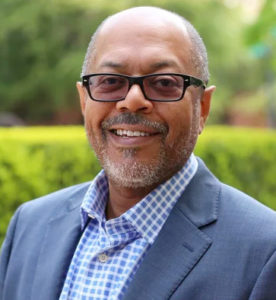
Kevin Merida
The 66-year-old editor remained upbeat about the newspaper’s future despite the continuing challenges of huge drops in circulation and advertising, layoffs of editorial staff last summer, and upcoming afternoon deadlines next year when the newspaper is printed in the plant of the Riverside Press Enterprise.
Merida took heat during the lunch meeting over the significant changes already implemented to the Sports section because of staff cuts and experimenting with earlier deadlines. But he responded that the editorial staff is still producing quality journalism, including earning two Pulitzer Prizes last spring.
He confirmed that the paper is unlikely to drop the print editions on Mondays and Tuesdays, because such moves don’t save enough money to be meaningful.
He also rejected the idea that in the near term the paper could print only the Sunday paper (which still has significant advertising) and publish digitally the other days to save production and distribution costs. “We need the print revenues to support digital,” he said.
The paper continues to seek new revenue streams, including books published by staffers, special events, and publishing special “guides” on different topics. “We’re even looking at games,” he said, citing the New York Times’ success with Wordle, which it purchased on Jan. 31, 2022.
While the paper will always provide accountability journalism, he said, “we know from our digital research what people like and what they don’t like.” He made it clear that readers like helpful lists of all kinds, and acknowledged that 22% of the stories in the print edition are not read by most readers, though he did not provide details about the research.
Merida was not willing to suggest how much print circulation is expected to drop from prior estimates of 118,000, but he did say that digital subscribers have grown to about 650,000 from the previously reported 550,000.
What is the goal for digital subscribers over the next three to five years? “As many as we can get,” he responded, smiling.
Merida said he thought the paper had done “a really good job” of covering the Mideast crisis, adding that he has asked reporters to focus not on day-to-day coverage but on stories that “differentiate what we offer from others.”
In a side conversation, he said the editorial staff is now close to 50% journalists of color.
This was the first in-person meeting of the OFS since the start of the pandemic. Efforts to Zoom the session met with great difficulty due to spotty Wi-Fi. The program was not recorded, so there is not video available of the portion that was distributed via Zoom, as is usually provided for those who can’t attend.
Times Sports Editor Is Making The Best of a Bad Hand
By Bob Rawitch
Good card players know when they’ve been dealt a bad hand. When Liliana Limon Romero was handed the position of Assistant Managing Editor for Sports, she never had any doubt.
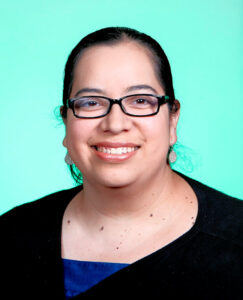
Iliana Limon Romero
Romero, who spoke to the OFS via Zoom on July 25, 2023, was recruited to join The Times as deputy sports editor in March of 2021 by former Times assistant sports editor John Cherwa. He had brought her to the Orland Sentinel when Cherwa was sports editor there. Ten months after arriving, she was named Assistant Managing Editor for Sports, succeeding Chris Stone.
Romero told the OFS attendees that she was accustomed to the challenges of today’s newspaper business. One of the papers she had previously worked for, the Albuquerque Tribune, had shut down. She had been through 12 staff layoffs at that paper and others in Orlando and El Paso. Those experiences helped prepare her for what she has had to face in the last month at The Times, she told the OFS group.
Layoffs in July cost 73 editorial employees their jobs. Sports lost a dozen staffers and all but one member of the copy desk. Many of the functions formerly handled by copy editors and digital staffers have had to be absorbed by reporters and line editors.
In addition, plans for the move next year of printing operations from the Olympic Blvd. plant (sold by Tribune Co. when it still owned the Times) to presses of the Riverside Press-Enterprise had included six months or more to prepare for the new, much earlier deadlines that move would require. After the layoffs were announced, she was told she had only three to four weeks to re-envision the sports section.
Romero’s solution has been to focus sports coverage on excellent writing, features, investigative and enterprise stories, along with bold photos. With deadlines moved up to 3 p.m., and a shrunken staff, she had to forsake game coverage, box scores, and standings.
“We’re definitely building the car while it is moving,” she said, suggesting that the changes she has made are not cast in stone. There were widespread complaints from readers about the loss of box scores, standings, and TV listings, she acknowledged. TV listings were reinstituted after a week, but baseball box scores and league standings were not, because the paper doesn’t have the staffing to handle it.
The tabular information delivered by the Associated Press doesn’t transfer automatically to the paper’s digital platform, including them would require manual processing that the reduced staff size cannot provide. In addition, she said, this information is readily available elsewhere, often in a better format.
The Times is far from alone in making such changes, she noted. More than 150 newspapers, including the San Francisco Chronicle and the Philadelphia Inquirer, have stopped carrying box scores, and the Associated Press is considering dropping them as well.
When she took the editor’s job, Romero said, the charge given to her was to “cover SoCal teams that SoCal residents care about.” That includes 11 professional teams, two big university programs (USC and UCLA), and 200 high schools.
With the new early deadlines and fewer resources, accomplishing that goal has become much more challenging. So, when making decisions, the question she now asks is, “does it serve our readers?”
In a note to Sports readers about the change in focus, Romero was candid about her regrets for the loss of coverage. “I was not going to be disingenuous,” she told the OFS group. “We’re just not in a position to do what we used to.”
There undoubtedly will be more changes as the football season starts, and then basketball, if the sports section doesn’t get more than the 5½ pages it is now allotted in the back of the California section.
Romero said she is still in talks with the paper’s management about potentially bringing back a stand-alone Sports section next year, when the paper is printed on the presses of the Riverside Press-Enterprise (which, ironically, was purchased from Tribune Co. when it owned The Times.)
Asked during the OFS session if the print edition might cease entirely, or might be produced only a few days each week, Romero said Chris Argentieri, the president of the paper, has given no hard answers on this point. But, she added, Argentieri has said he “doesn’t think there is a financial advantage” to dropping to fewer days of the week.
To view a video of Romero’s talk, go to https://tinyurl.com/43db98tb.
Church-State Wall is Open a Crack But Still Intact,
Says L.A. Times Senior VP
By Bob Rawitch
Hired from online magazine Slate five years ago, initially to oversee L.A. Times entertainment coverage, Julia Turner, the paper’s new senior vice president for content business strategy, says she is still figuring out on a day-to-day basis what the position entails.
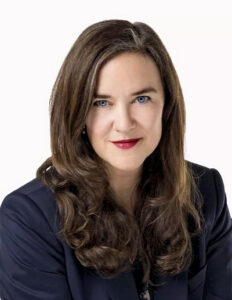
Julia Turner
In a Zoom call with the OFS in early May, 2023, she made it clear the traditional church-state separation between editorial and the business side of the paper remains sacrosanct. However, she said there is a slight departure from the days when no one on editorial was allowed to talk to those in advertising.
(See a video of the Zoom session at: https://youtu.be/M1u9C0OCg00.)
“My job is to help make sure that the business side is capitalizing in the best possible ways on the excellent journalism we do,” Turner said, adding that “the advertising side can never influence what journalism does, and the audience cannot ever be confused about that.”
She noted the days are long over when hundreds of millions of dollars rolled in from classified and display advertising and editorial’s job was to spend the money. “The challenges are very different,” Turner said. “We have to communicate in ways that don’t require editorial to compromise in any way.”
Asked if that means that she sits in on business-side meetings, or that business-side representatives sit in on editorial meetings, Turner didn’t directly respond. She said she is currently on a “listening tour” to see how the two sides are now communicating – or not – so they can better understand one another.
The daughter of two newspaper journalists who spent 15 years at Slate and was ultimately its editor before she joined the Times, Turner talked about the challenges The Times faces attracting younger readers and Latinos, the largest ethnic group in the Los Angeles region.
These efforts entail extensive research about what it will take for the two groups to engage with the paper (primarily digitally), as well as experimenting with new products.
She said the paper currently produces the L.A. Times en Espanol website and is publishing some stories in both English and Spanish, although its focus is on English-speaking Latinos. One of the paper’s 20-plus newsletters is the weekly Latinx Files, described as “stories that capture the multitudes within our communities, spanning culture, sports, politics and local news.”
There are several other efforts underway that she said that she could not yet discuss publicly. But she said the paper is studying Latinos’ relationship with news sources and news consumption habits. “The idea of a relationship with a (news) product you pay for is not universal” within the Latino community, Turner said.
As for attracting a younger audience to The Times, Turner cited research being done to determine what younger readers are seeking and how to present that information. She said this includes podcasts, newsletters and social media.
But the social media platforms that work are constantly changing, she said, noting that Facebook has walked away from being a primary vehicle for news and “Twitter is essentially dead.” However, she said, Google and Apple News remain “substantial drivers” of readers to the paper’s digital products.
Turner said the The Times has “around 350,000” digital subscribers, but declined to disclose the paper’s target, noting that it depends on which model is used in terms of revenue from other sources. “We want more,” she said smiling.
She briefly addressed the threat to the news media from Artificial Intelligence, saying the paper is joining others to lobby against ChatGPT “essentially sending our content to others for free,” but did not elaborate on what those efforts entailed.
Turner was asked what involvement, if any, the Walt Disney Co. had in an April 20 supplement about the 67-year-old theme park that focused on “tips and tricks” for having a good day at the park.
As a transplanted easterner, she said she had no idea when she arrived in L.A. how central Disneyland is to so many people, but that the company was not involved in the genesis or production of the supplement. Rebuffing the implication that it was a puff piece, Turner noted that there were several critical stories, including one about the park’s pricing.
Speaking more broadly, she said the supplement was part of the paper’s efforts to provide more information that is a reader service. Turner said she “has no idea” whether Disney liked the supplement or not. There might be other such efforts, she said, potentially about the Hollywood Bowl, another important regional institution.
“We need to be indispensable to Southern California readers, but that is not the total of our ambition,” she said. Even with a newsroom staff that is far less than half the size of its peak years ago, she said, “if we tell stories that matter here…we will be necessary and viable across the world.”
Digital Info Critical to Operating L.A. Times, Two Editors Tell OFS
By Bob Rawitch
Digital data and analytics are integrally built into much of what the L.A. Times produces daily in both print and online editions, two Times editors told the OFS in a Zoom talk Feb. 26, 2023.
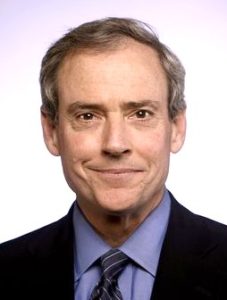
Scott Kraft
Editor-a- large Scott Kraft and Samantha Melbourneweaver (cq), assistant managing editor for audiences, said that analysis of what readers want, what they read, how long they spend reading an online story, and much more is integrally incorporated into producing the print and online editions and the multiple uses and platforms for Times stories.
Quick to reject any suggestion that the paper is just after “click bait,” both editors said readers in fact most want the kind of journalism The Times is known for and does best: investigative stories, projects and breaking news.
“People will pay and give us their dollar for the really good legacy work we are known for,” said Kraft, a 38-year veteran of the paper, “like coverage of climate change, homelessness, city hall corruption….”
Because of the digital edition of The Times, he said, some stories reach a far larger audience than even at the height of the paper’s print-only days, when daily circulation exceeded 1.1 million and Sunday circulation was more than 1.6 million. There were nearly 5 million page views for coverage of the recent shooting deaths of 11 Monterey Park residents, he said.
With a breaking news desk overseen by Deputy Managing Editor Shelby Grad, Kraft called the paper “still a breaking news machine” that has won four Pulitzer Prizes for breaking news, more than any other paper in the country.
Kraft acknowledged that, with fewer than 150,000 print readers and about 380,000 digital subscribers, the paper is reaching only a “miniscule part of our potential audience.” But he noted that even at its height the print operation also never had a high penetration among Southern California’s 12 million residents. But that’s “both a challenge and an opportunity,” he said.
In introducing Melbourneweaver, who has been with the paper for about four years, he said she and her staff are able to closely track readers’ reactions to specific articles as well as to categories of content and are “helping to lead efforts to be innovative in how we reach younger audiences who live on Instagram.”
Melbourneweaver, who grew up in the San Fernando Valley and graduated with a degree in journalism from Arizona State University, said the demographics of Times print and digital subscribers are the same, to the extent they are known. But the former’s average age is in their 60s, while the digital readers are in their 40s.
She said some members of her 40-person team involved with audience engagement are “embedded” within major departments of the editorial operation.
There are two in Metro, three in Calendar, one in Business and one in Sports. Those individuals sit in on all departmental meetings, talk with reporters and editors, and make suggestions on how to maximize the readership of stories based on their research. Suggestions may address headlines, second-day stories, or inclusion of specific search terms so stories will pop up on sites like Google.
If the paper determines that a story needs to be posted online immediately, Kraft said, the newsroom will sometimes post it first and copy edit it afterward, making any necessary changes after it is online.
The bulk of the paper’s digital subscribers are in the five-county region of Southern California, with very few outside California, Melbourneweaver said. There are “a couple thousand” in New York. Most digital subscribers locally are thought to be middle aged, white and live on the Westside.
A digital reader spends an average of only a few minutes on the Times site, with exceptions for those who may spend five to eight minutes reading a long enterprise story. The average time reading a single story is 30 seconds. (In the ‘80s and ‘90s, most surveys showed readers spent 20 to 30 minutes reading a daily newspaper)
She added that only about 30% of print subscribers also activate their digital subscriptions.
Kraft, appointed editor at large in May but still doing double duty as managing editor until a successor is named, said print circulation continues to decline, and the paper’s digital audience is not growing fast enough to make up for the losses.
But he said there are still no plans to drop Monday or Monday and Tuesday print editions, as many other large metro dailies have done, just maintaining digital editions on those days. Such a decision is a complicated one, he said, and no doubt will be impacted by two non-editorial or readership issues.
One is state legislation which will soon make it much harder to hire independent contractors to deliver the paper, he said, while a second is plans to close the Olympic Boulevard printing plant in June 2023. After this date the paper will be printed in Riverside County by the Southern California News Group, which owns the Riverside Press Enterprise, Daily News, the Register, South Bay Daily Breeze and many other regional publications.
The former owners of the Times sold the building containing the presses before Dr. Patrick Soon-Shiong bought the paper but leased the facility back to the paper until June 2023.
“We still don’t know what that will mean for delivery of the paper or editorial deadlines,” Kraft said, “which is why the announcement (of the plant closing) was made a year and a half ago, to give us time to figure that out.”
Times Guild Unit Is Negotiating Work-At-Home Rules,
Union President Tells OFS
By Bob Rawitch
The work-at-home arrangements required during the COVID pandemic proved that L.A. Times reporters can do so effectively and at the same time improve the quality of their lives, the head of Media Guild of the West told members of OFS on Oct. 26., 2022

Matt Pearce
A video of Matt’s talk can be seen on YouTube.
Matt Pearce, 37, a national correspondent who heads the Times guild unit and chairs the umbrella union group for a number of West Coast guild units, said getting permanent work-at-home rules for reporters is currently being discussed with Times management as part of negotiations for the union’s second contract with the newspaper.
Citing recent high inflation, he said an increase in pay for guild members is of course on the table. The current three-year contract, which expires Nov. 2, provides for 2.5% annual pay raises. But working remotely at least part of the work week is important to staffers, many of whom, have two-hour or more round trips to the offices in El Segundo.
Pearce said not only is there the high cost of gas to commute, but such long commutes mean time away from sources, time away from family, and is generally stressful on staffers.
As the Times expands into many non-print forms of journalism, Pearce said, this diversification has raised issues of who can be a member of the guild. Many people from audio and video sections of the Times are now members of the Guild unit, including a puppeteer who works in the department that produces videos for TikTok.
While Times management has a professional labor negotiator on their bargaining team, the Guild negotiators consist of eight members of the newsroom, led by Pearce. He said negotiations will clearly go beyond the Nov. 2 contract expiration date, what he called a “soft deadline.” But the Guild is incentivized to reach agreement, because there will be no raises until a new contract is signed.
Currently, the 450 employees represented by the Guild pay dues of 1.3846% of their base pay, lower than most newspaper Guild units. At The New York Times, where there are far more members, the figure is 1.75% of base pay, he said.
Under the current contract, a reporter with one year of professional experience receives a minimum annual pay of $61,000, rising to $81,000 after five years. For reporters with 21+ years of experience, the minimum is $116,000. Critics and columnists are paid from about $92,000 to $123,000 depending on their total years of professional experience. Merit raises, he said, are very rare and not very large.
Pearce said another issue that will be negotiated is the extent to which reporters and others will be involved with, have some control over, and be paid for secondary uses of their original work product. These ancillary uses may include podcasts, movies, documentaries and forms not yet invented.
These non-traditional products also create challenges for the Guild, because they often involve non-Times (and therefore non-Guild) employees who are independent contractors. Pearce said the contract negotiations will include discussion of when independent contractors should be used, how much they will be paid, and the benefits they receive.
Despite not having a professional negotiator working with them in the bargaining sessions, Pearce said, “we are considered equals at the bargaining table. Management and its reps could have played hardball on some things, and they haven’t.” But he noted the two sides haven’t yet gotten to some of the big issues that will cost a lot, so he reserved the right to reevaluate the process down the line.
When the newsroom was unionized in 2018, younger staffers of color were a driving force because they were paid far lower wages than those who were older and predominantly white. The first contract brought most of those staffers up to salary levels commensurate with their experience, and for the first time established minimum salaries for dozens of job classifications.
The newsroom is now among the most diverse in the country among major newspapers. But while acknowledging the more diverse newsroom, he said the paper still has a long way to go, particularly in hiring more Latinos.
Currently, the newsroom is 54% White, 21% Latino, 16% Asian-American and Pacific Islander, and 6% Black. The remainder are “other” or have declined to state their ethnicity. Pearce noted that Los Angeles City is 50% Latino, though he did not say that was the Guild’s goal for Latino representation in the newsroom.
Hundreds of Times Employees Served in Second World War; Eleven Perished, Paper’s Historian Says
By Bob Rawitch
While the names of the Los Angeles Times employees killed in World War II are little known, Times Historian Darrell Kunitomi is doing his best to make sure they are not forgotten.
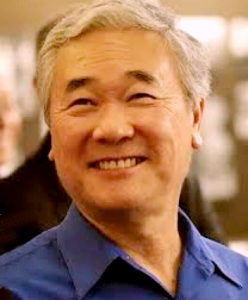
Darrell Kunitomi
The 45-year veteran of the Times spent part of the COVID shutdown period developing a presentation about the Times in World War II. In a talk with OFS group of Times retirees via Zoom on August 11, 2022, he spoke about those from the editorial department who died, as well as those who fought and returned to the newsroom.
When the United States entered the war after the Dec. 7, 1941, attack on Pearl Harbor, hundreds of the Times’ then-1,700 employees joined the military. These included two women, a switchboard operator and a woman from the secretarial pool, Kunitomi said. Eleven Times people died in action.
In a presentation filled with wartime photos, recruiting posters and other depictions of the war years, Kunitomi explained the impact on the Times.
Ink and paper were rationed, as was gasoline and tires.
Women replaced men in the work force. Among them was the first female photographer at the Times, Maxine Reams, who spent nearly 30 years at the paper.
Ninety percent of the Times employees gave at least 10% of their income to buy war bonds or in other financial ways supported the war.
The 11 killed in action were:
- Howard Stivers, pressroom
- Staff Sgt. Robert A. Arent, purchasing
- PFC Paul Humphrey, engraving
- Paul Menaul Jr., printing and binding
- Frank R. Paul, communications
- Paul Roberts, dispatch
- Edric A. Simons, composing
- Bob Smyser, editorial
- Claus S. Wells, editorial
- Tom Treanor, the paper’s war correspondent
- Coxswain Frank Montoya, circulation
Kunitomi said he has not been able to identify the positions Smyser and Wells held in Editorial, in part because he doesn’t have access to issues from the era of “Among Ourselves,” the Times’ in-house tabloid newspaper.
Editorial staffers who were known to have served in the military and returned to the Times after the war were columnist Jack Smith, artist Jimmy Frankavilla, and medical writer Harry Nelson. Before he joined the newspaper in 1965, National Editor Ed Guthman served in the Army as a Captain, earning a Silver Star and Purple Heart.
During the OFS session, former reporter Evan Maxwell added that long-time Orange County Reporter Gordon Grant had also been a war correspondent, and lost an eye from a war injury.
Kunitomi noted that Times correspondent Tom Treanor chose to put himself in jeopardy so often that he was often compared to Ernie Pyle, who won a Pulitzer Prize for his wartime stories about common soldiers. Pyle was killed in the battle of Okinawa.
Treanor, who Damon Runyon called “one of the four best reporters developed in this war,” died in a Jeep accident in August of 1944. He was accompanying troops sweeping out of Normandy to free France from Nazi control. He left a wife and three children. His autobiography, “One Damn Thing After Another,” was published posthumously.
The eleventh and last Times employee died in action on July 30, 1945, three days before the war ended.
Frank Montoya, a circulation employee who enlisted in the Navy a few days after turning 17, was aboard the USS Indianapolis. The cruiser was on its last mission after delivering the first A-bomb components to the island of Tinian in the South Pacific.
The ship, designed for speed and equipped only with thin armor, was hit by two torpedoes from a Japanese submarine and sank in just 12 minutes. About 300 of its 1,195 crewmen were trapped below decks. An estimated 890 were forced to jump into the sea.
Rescue ships did not arrive until the sailors had spent four days in the shark-infested waters. Only 316 were still alive. Montoya was not one of them.
The loss of the ship and 879 of its crew remains the Navy’s worst loss of life at sea, Kunitomi said.
Kunitomi showed a photo of the plaque that hung in the Times lobby at First and Spring Streets commemorating the four Times reporters killed in the course of their work: Treanor; Joe Alex Morris, shot dead in 1979 during a battle in Iran; Ruben Salazar, killed in 1970 in East LA while covering the National Chicano Moratorium protesting the Vietnam War, by a tear gas grenade fired by a sheriff’s deputy; and Dial Torgerson, assassinated in Honduras in 1983 when an anti-tank mine exploded under his rented Toyota.
A few years ago, Kunitomi said, he stopped to observe a Trump rally and happened to strike up a conversation with a KTLA cameraman – who turned out to be Torgerson’s son, Robert.
To view the Kunitomi video presentation click here, or go to https://us02web.zoom.us/rec/share/8PyVNpT82k1yIiGw4vWKpDQNlR7Q7jyFMudq4doQw2XYhjQrs4ATRNkf1OwYEwSV.Qy_9gNBjcWaKikli.
L.A. Times Editorial Page Editor
Comes “Home” After Four Decades
By Bob Rawitch
Joining the Los Angeles Times editorial pages in 2019 was a homecoming of sorts for Terry Tang, the daughter of Taiwanese immigrants who grew up in Gardena in the 1960s and then spent 16 years newspapering in Seattle before working at the New York Times for 20 years.
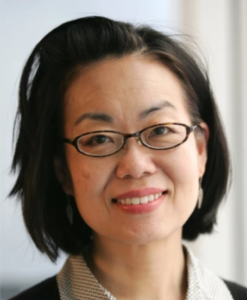
Terry Tang
Speaking to the OFS by Zoom on May 26, 2022, Tang discussed how much the Los Angeles region has changed while she was gone and how those changes relate to the content of the Los Angeles Times editorial and Op Ed pages.
She noted the population had increased by at least 30%, resulting in massive changes to housing and transportation patterns.
“Housing for young people is impossible,” she said, at least in regard to buying a home in Los Angeles, where the median price was more than $800,000 in April according to the Los Angeles Almanac.
She said that transportation, social services, and homeless issues are other central problems about which the editorial pages opine.
But despite the problems the region faces, Tang said “California will always be the golden state. The people who live her, the diversity, the cultural energies here – you can’t really replicate it.”
It is difficult to compare the editorial pages of the New York Times and the Los Angeles Times, she said, because they are so different, including the focus of editorials.
The New York editorial writers are far more focused on international affairs, to the point where the paper “has really unplugged from local issues” in recent years, Tang said. Most of the New York paper’s print and digital circulation is outside the state of New York. Currently, the paper does far fewer editorials in general, preferring signed columns, she said. There are 14 staffers for the editorial pages, including editors. Paid circulation for the paper last month was 6.1 million, but less than 350,000 were print readers.
The now-much-smaller L.A. Times, with its circulation concentrated in Los Angeles County, writes extensively on criminal justice reform, homelessness, and natural resource issues, said Tang, who has eight staffers working for her, including the letters editor. Whereas the New York Times would be unlikely to comment on the New York state budget, the L.A. Times takes a deep interest in the issue, she added.
Tang expressed pride in increasing the diversity of the Op Ed page writers and content, and said there are now five staff columnists who bring their life experiences and points of view to the pages.
She said she hopes to “surprise” readers periodically with the content, including “graphical op eds” that periodically appear on the page.
Asked about the editorial board’s process for making election endorsements, Tang said she did not think the process had changed significantly, other than many of the interviews with candidates took place by Zoom. Top candidates for almost every major race were interviewed for about 25 minutes each by editorial board members who also did their own independent research on the candidates. That was particularly critical, she said, in recommendations on judges, whose candidates are mostly unknown to the public.
She said owner Dr. Patrick Soon-Shiong was kept apprised of all endorsements and was invited to sit in on the interviews. She did not say whether he in fact monitored any of the key interviews, noting the newspaper is one of many businesses he owns. Tang said she did not believe any of the endorsements “shocked” Soon-Shiong, because they were a natural extension of the editorial positions and values the editorial board has taken over the years.
A video of the OFS conversation with Tang can be viewed at https://us02web.zoom.us/rec/share/pTir30jc3yqTEOysu9bFX6b8Y3M0ljODaeqgsF45qYIFyoXyXAMvVNk6WntW5TeK.02_b9OR_QZ4hAwOj
The video starts a few minutes into the presentation, because the host was a little slow to hit the “record” button.
Times Must Reach Younger and Lower-Income Readers to Survive, Says DME Shelby Grad
By Bob Rawitch
The L.A. Times reader base has always been coastal-based, white, older and wealthier, but if it is to succeed in the digital area it is going to have to attract and retain younger and lower-income readers, Shelby Grad, deputy managing editor for news, told the OFS in a Feb. 3, 2022, Zoom call.
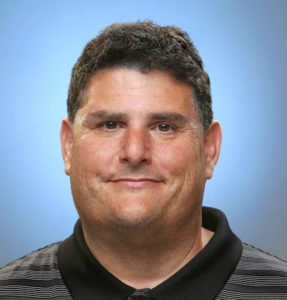
Shelby Grad
Since Dr. Patrick Soon-Shiong purchased the Times three and a half years ago by, the newspaper has hired more than 140 editorial staffers, many of them people of color, and dramatically increased its coverage of ethnic communities and people of color. Today it has the most diverse staff in the nation, with almost 40% people of color and nearly 50% female.
But Grad, who has been with the paper for more than 25 years, told the OFS his goal is not just to increase coverage of minority communities, but to attract more readers among non-wealthy and working-class residents of L.A.
“L.A is a very stratified place,” he said. “There are a lot of people who have money and are making a lot of money, but many, if not the majority of working class and service class are not, and they are less likely to afford a Times print subscription or to want the paper.”
Grad called bridging that divide the “central, existential question” not only for the paper but for many other institutions in L.A.
As the staff and the news hole has shrunk over the years, Grad said, the paper has been forced to alter its coverage from the previous geographic approach in which it “chased readers in the suburbs,” to a more topical and beat approach.
He said there just are not enough reporters to cover the region geographically. As a result, the former Orange County Edition, which at its peak had nearly 200 staffers, now has just a handful of reporters. Those reporters also produce the Daily Pilot, a Times property.
As much as the paper has increased its coverage of communities of color and ethnic issues, Grad says he still hears from people in the community that it has not done enough. They tell him, he said, “You come to us when there is a big problem, a shooting or a health crisis, like COVID, but you are not here all the time reporting our stories, really getting into the community.”
Grad acknowledged it is a challenge to provide enough news about communities of color while still satisfying the needs of predominantly Anglo, wealthy, long-time readers.
He said the paper does not know with certainty the racial or ethnic makeup of its 160,000 subscribers, but it has a pretty good sense based on where the paper is delivered.
Geographically, the highest penetration of the paper remains in upscale communities such as Brentwood, Bel Air, Santa Monica, Pacific Palisades, Pasadena and San Marino, he said. In some ZIP codes with predominantly non-white populations, the paper has fewer than 100 subscribers.
The effort to expand the digital circulation, along with the topical/beat approach to covering the news, has effectively shifted the focus of the paper’s coverage to Los Angeles County, he said.
The loss of print circulation, he noted, is not restricted to the L.A. Times. The New York Times and Washington Post have also suffered print losses. Maintaining the million-plus circulation the Times had in years past would have required a massive effort to constantly sign up new subscribers, because of the turnover of existing subscribers. With the emphasis now on digital, that effort is no longer made.
Grad said the interests of digital readers are very similar to print subscribers: local government, homelessness, transportation, politics and the arts.
He recalled when he came to the Times as a stringer in the Orange County Edition in 1993, Calendar was a thin section, but today it is robust and brings in much of the paper’s advertising revenue.
In response to a question, he said the paper does not want to be “celebrity-centric,” but its arts and entertainment coverage is a “big part of the brand.” He noted the paper’s staff led the nation in the coverage of the accidental fatal shooting by actor Alec Baldwin of a cinematographer on the set of the movie “Rust.”
Another way the paper is trying to make its mark and satisfy the needs of digital readers is a restructuring the staff to focus aggressively on breaking news. New Assistant Managing Editor B.J. Terhune coordinates a team of reporters that crosses all sections and is dedicated to jumping on breaking news stories, like the Rust shooting or the beating of a 49ers fan in the parking lot after the Rams-San Francisco football game a few weeks ago.
Grad said print circulation was in “terminal decline,” and at some point the paper may have to stop producing a print edition on Monday and Tuesday, although he would not predict when that might happen. He said the print product still produces far more revenue than the digital product.
He had high praise for new Executive Editor Kevin Merida as an innovator who recently reorganized the hierarchy of the staff, including elevating Grad from overseeing just California news to overseeing the entire daily news offering. He was confident Merida will find a way to make the Times successful, but it will require going where readers are, not just making a better print and digital product. He said, “we need to find communities we want to serve and figure out how to reach them.”
Finally, while at the Times headquarters in El Segundo the last two years there has been an addition to the building to accommodate more meeting space, a test kitchen, a parking garage, and outdoor dining space, only a handful of staffers actually work in the newsroom. Everyone else continues to work remotely because of COVID restrictions.
Like most white-collar businesses, Grad said, he expects in a post-COVID era most of the staff will likely work some kind of flex schedule, potentially working from home a few days a week.
He acknowledged that when the El Segundo offices were opened, there was a loss of some staffers who were unwilling to make the commute from the eastern part of the city (then convenient to Times Mirror Square). But many new staffers live in the South Bay, Mar Vista and Inglewood areas, and with flex schedules the paper’s new location may help it attract and keep talent.
To view a recording of Shelby Grad’s discussion with OFS, go to:
https://us02web.zoom.us/rec/share/sLE9HylYZyqEZs4lARCIHtyTpgRH_QxfIYrUUB9ordTOfZnLypqpb5LudHbUemJL.W_Ui2kQY6WIYXn-A
Use the Access Passcode: OFS2022! (Note the exclamation mark at the end.)
L.A. Times Executive Editor is Looking Under the Hood to Find Gaps and Motivate Staff
By Bob Rawitch
Kevin Merida, executive editor of the Los Angeles Times, has spent his first five months “looking under the hood to see where gaps are and motivating the staff,” but its clear his overall goal is building the number of digital subscribers and creating a “modern media company.”

Kevin Merida
In a 90-minute Q&A with the OFS group of Times retirees and former editorial staffers on Zoom November 8, 2021, Merida acknowledged that the Times has less than 1% digital penetration in Los Angeles County.
“You can look at that as either depressing or as nothing but an opportunity,” he said, making it clear he sees it as the latter.
Merida said he grew up reading famed Washington Post sports reporter Shirley Povich, and was honored to work at the Post while Povich was still there. At the Post he eventually rose to the rank of managing editor.
In 2016 he was hired by the Walt Disney Co. to oversee the ESPN sports startup The Undefeated. This extraordinarily successful venture describes itself as the “premier platform for exploring the intersections of race, sports and culture.”
As much as he loves newspapers, Merida said The Undefeated gave him the opportunity to oversee television shows, and to be a part of building a brand within the Disney Company.
It also allowed him to “connect with the “whole range of storytelling, which I hope to use at the L.A. Times,” he said.
In his talk with the OFS, Merida repeatedly returned to the theme of the multiple platforms the Times intends to use to raise its profile and to attract and engage readers who are not currently taking the print or digital versions of the paper.
He recently authorized hiring 15 members of an “engagement team” whose job is to “find different ways to bring our work to audiences where they are.”
Members of the team will take projects produced by reporters and come up with ways to amplify them through social media and other platforms “to get the word out about our work,” he said.
“We need to build up entry points for people who haven’t thought of us,” Merida explained. His hope is this strategy will stop people from cancelling the print or digital product and going elsewhere for what they want.
He rejected comparisons to the New York Times or Washington Post, particularly the nearly six million digital subscribers the New York Times has.
Unlike former publisher Otis Chandler, who famously pledged to “knock the New York Times off its perch,” Merida told the OFS, “We are not the New York Times and don’t aspire to be… We have to focus on who we are, where we are.”
He acknowledged that the L.A. Times was “a little late to see the potential” of the Internet. “We didn’t change our business,” he said. “We weren’t fast out of the gate with the technology.”
But he said the Times is investing heavily in improving its infrastructure to increase its digital subscribers.
Merida spoke about the publication’s strong areas of coverage, including the entertainment industry, the environment, and investigative projects. He said the Food Section will be expanded, the Image section can become a “cultural brand,” and the Envelope will at times be a “special, premium product that will be glossy” around award seasons.
He said correspondents have been added in Mexico City and Beijing, and he praised the work of the Washington, D.C. bureau despite the recent departure of some well-established and respected reporters.
Now 64 years old, Merida was asked how long he intended to lead the paper and whether he had given any time commitment to owner Dr. Patrick Soon-Shiong.
He responded that he serves at the pleasure of Patrick and Michele Soon-Shiong, but “I’m here for the long haul, not the short term.”
He added, “some things take time. There are no quick fixes.” He said he is currently working on “building out the L.A. Times studios to link (stories) more deliberatively and intentionally.”
He also said he is building up podcast teams, and is trying to hone audio and video teams.
“We are constantly trying new things,” Merida said. “If it works, do more of it. If it doesn’t work, try something else.”
Merida said historically the news media has not done a good job of educating people about its role or why publications do what they do. Instead, the media have “allowed others to do it who don’t have our best interest at heart. Sometimes there is willful misunderstanding.”
Journalism has always been questioned and debated, including accusations that some publications are biased, but this is “more amplified now because of the digital era. Everyone has a megaphone,” he said.
Part of his job, he said, is greater public outreach through “town halls, explaining our craft, explaining how we do things, and answering questions.
He feels he will also benefit by “getting outside the newsroom bubble.”
Merida said he has met with the paper’s Black and Latino caucuses, and he respects what they do. He added he “doesn’t believe one needs to hold a masthead position to be a leader in the newsroom.”
D.C. Bureau Chief Kimbriell Kelly Speaks to OFS
By Bob Rawitch
Among the many challenges of overseeing the L.A. Times Washington Bureau is finding ways to display stories over the multiple platforms of print, online, podcasts, newsletters, Twitter and Facebook, Bureau Chief Kimbriell Kelly told the OFS July 13, 2021, in a Zoom call.
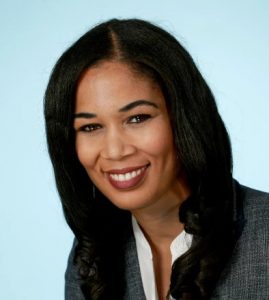
Kimbriell Kelly
Approaching her one-year anniversary as bureau chief, Kelly talked to the OFS from inside the Washington Bureau. She said it was the first time she had been in the office since March of 2020.
Before taking over leadership of the bureau, Kelly was deputy editor for enterprise and investigative projects in the Washington bureau. She led the editing of immigration coverage that won the bureau its first Pulitzer in 17 years.
She joined the paper from the Washington Post where she was an investigative reporter. She was a part of a Post team that won the Pulitzer for national reporting and was runner-up three years later.
Asked during the OFS Zoom call about a protest letter sent to her by 21 staffers about her disciplining of a bureau editor for insubordination, Kelly demurred, saying she could not address the topic because it was a personnel issue. The cause of the disciplinary action has not been publicly disclosed.
Responding to a question about her philosophy of coverage, Kelly said she generally puts stories into one of three “buckets:” breaking news, enterprise reporting and accountability journalism.
She said she seeks opportunities where reporters can take stories to an elevated level so they are more meaningful to readers.
Current reporting on former President Donald J. Trump is on a case-by-case basis, she said, in sharp contrast to when he was president and virtually his every utterance was covered by the news media.
She said attention paid to Trump would likely increase in the coming months, given all the litigation surrounding his businesses and accusations against his organization’s chief financial officer.
With more analytical data available on readers’ habits, she said, editors now know in detail what readers want and read, including how many minutes they spend reading a story online.
The bureau currently has about 30 staffers, and she doesn’t expect that number to increase in the near term; in years past the bureau was home to between 40 to 60 staffers.
With Vice President Kamala Harris coming from California and the state having the largest congressional delegation, Kelly said she is adding a third reporter to cover Congress, with a particular focus on stories about California or about issues that impact the state, such as the environment and immigration.
A graduate with a BA in English from Xavier University and an MA in journalism from Boston University, Kelly has taught journalism classes at American University and Princeton and currently is teaching an online investigative reporting class at University of California, Berkeley.
With most pandemic restrictions lifted in Los Angeles, the OFS expects to return to in-person lunches, but will continue to use Zoom at our meetings to enable the largest number of people to participate.
To view a video of Kelly’s remarks, click on this link.
LA Times to Have Major Olympic Presence,
Says Executive Sports Editor
By Bob Rawitch
The L.A. Times will have the second-largest contingent of sports staffers covering the Summer Olympics behind NBC, which is broadcasting the games from Japan, Christian Stone, the paper’s executive sports editor told the OFS.
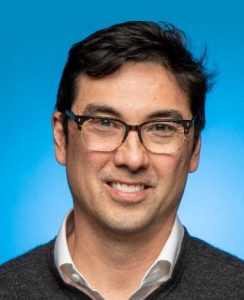
Christian Stone
The Times will be sending 14 reporters and photographers to Tokyo and will produce a separate daily color section, as it first did in 1984 when the games were held in Los Angeles, he said in a lunchtime Zoom call on May 12, 2021.
Stone, who spent almost his entire journalism career at Sports Illustrated, leaving in 2019 after serving as editor in chief, responded to a wide range of questions. These ranged from his plans for future coverage in the post-Covid era to how the department operated remotely for the last 15 months during the pandemic.
The Olympics discussion was off the record, because Stone did not want his competition to know the paper’s plans. He shared some of what the paper will be doing in its print and digital Olympic coverage. The time difference between Tokyo and Los Angeles, he thinks, will give the Times an advantage over East Coast-based papers.
Stone told the OFS he hopes to start bringing the editing staff back to the El Segundo offices incrementally in July, in part because he believes the staff is more efficient and more creative when it can meet face-to-face.
He added, however, that the paper also may allow some editors to work from home regularly one or two days a week. He noted that some of his editors live in Santa Clarita and Ventura County, making for a three-hour roundtrip commute.
The entire staff left the building 15 months ago. Since then, he said, the editing staff has held two Zoom meetings a day to plan coverage and deal with any issues, as well as a weekly “vertical” meeting with reporters by sport, i.e., professional baseball, basketball, collegiate sports, etc.
Even in pre-pandemic days most sports reporters were seldom in the office, Stone said, but all were badly handicapped during much of the past year by Covid travel restrictions that until recently prevented them from traveling with teams and limited their access to the athletes.
He said to OFS member and former longtime sports reporter Steve Springer, “Can you imagine covering the Lakers watching on TV from L.A.?”
At Sports Illustrated, Stone was responsible for expanding the magazine’s coverage to multiple platforms, and former Executive Editor Norm Perlstein charged him to do something similar at the Times.
“Digital is bottomless,” without the space constraints of print, he said. “We can tell stories in ways that feel modern, engage our audience in new ways.”
He cited “Fernandomania,” a current series on former Dodger pitching great Fernando Valenzuela. The paper has released the first three of 15 planned video episodes, which have already drawn nearly one million views online.
Ultimately, he said, the project about the baseball phenom will include a 90-minute video, an extended podcast, and possibly an electronic “bookazine.”
“Digital just gives us ways to tell stories in new ways,” he said.
Stone said he “obviously” would like to return to a separate sports section seven days a week, as in pre-pandemic days. But “that’s an economic decision,” he said, adding “when we do, it will probably be a six-page section.” In the meantime, he said, when he needs extra space for special events “our bosses are good about giving it to us.”
He said he takes great pride that the Sports staff places more stories on the A section front page than any other newspaper in the country, including 18 Column One features last year.
Stone has a long list of coverage areas he would like to add or expand when he does get more news hole. This includes increased coverage of high school sports. He praised staffer Eric Sondheimer, who has covered high school sports in Los Angeles for 40 years, most of that for the Times.
Stone predicted that gambling on sports will likely be legalized in California in the next year or so. He envisions the Sports section will cover the issue, mostly in an educational fashion. He assured the OFS that “we won’t let our content be driven by the big sports books.”
He acknowledged that he personally seldom gambles, and that gambling presents a “moral quandary for some people.” But if it is legalized, he feels obligated to cover it.
Stone envisions that, with added space and resources, his staff will eventually cover the e-sports and fantasy leagues that appeal more to younger consumers. He also believes that the Sports section will produce live events that will engage readers and help strengthen the Times brand.
He and his editors are looking for ways to give their beat reporters the time to do more deeply reported stories every two to three days, he said, “but we’re still trying to figure that out.”
Will the Times Publish Fewer Than 7 Days a Week?
By Bob Rawitch
Like many American newspapers, the Los Angeles Times faces serious challenges that may threaten its ability to survive in print form, two of the paper’s senior editors told a virtual lunchtime meeting of the OFS on March 17, 2021. (See information below to access a video of their presentation.)

Scott Kraft
Speaking to 60 L.A. Times retirees on Zoom, Managing Editors Scott Kraft and Kimi Yoshino said some internal projections suggest the print publication might only survive five to 10 years.
Scott said he did not agree with this forecast, but Yoshino said she would not be surprised to see a move to publishing the print product on a less-than-seven-day schedule within two or three years.
If that day comes, Kraft said, a digital edition would likely be produced on the days a physical paper was not published.
Yoshino said Times projections “show a grim outlook for print,” noting that Sunday circulation is now below 300,000. In 1990 it hit a peak of more than 1.5 million, and daily circulation was at 1.1 million.
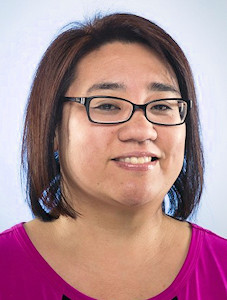
Kimi Yoshino
The massive drop in circulation — as well as advertising revenue — is an industry-wide phenomenon. It is a result of the digital revolution that started about 20 years ago as Craigslist, Facebook and Google began to capture eyeballs and advertising dollars.
Kraft cited outstanding editorial work during the past year that included coverage of the Covid pandemic and the national elections, new columnists and voices on the news and editorial pages and a new slick magazine called Image, remade from the broadsheet publication. He also pointed to new podcasts, one by Chris Goffard and another by columnist Gustavo Arellano.
Although the staff continues to work remotely, Kraft said he and Yoshino are working on plans to bring at least some staffers back to the El Segundo offices around Labor Day.
“I question whether the way we work has been fundamentally changed forever by Zoom,” said Kraft, who believes something has been lost through the inability to just drop by a staffer’s desk, as in the pre-pandemic days.
Yoshino said a new test kitchen is almost completed at the El Segundo site, a new parking garage has been completed , and early planning is underway for a visitor center and museum centered on the history of the Times.
There were questions from the attendees about speculation that owners Dr. Patrick Soon-Shiong and his wife will sell the paper – which the doctor strongly denied as recently as the week before the OFS meeting.
Kraft said he gives these reports no credence, and Yoshino added, “they don’t act like short-term owners.”
She noted that Michele Soon-Shiong has been meeting personally with staffers about the visitor center and museum, and their daughter has been actively engaged in outreach to the Black and Latino communities as well as the minority caucuses on the editorial staff.
Editorial staffing at the paper remains above 500, about 100 more than when the Soon-Shiongs bought the paper. Kraft said between 12 and 24 reporters are engaged in investigative projects virtually full time. He said examples of this team’s work included coverage of the lack of black members in the Hollywood Foreign Press Association, the unconscionable delays in access to medical specialists in county health facilities,and reporting on sexual harassment by top CBS executives that led to suspensions. An in-depth story about right-wingers in Orange County was published on the Sunday following the OFS meeting.
Asked about diversity efforts at the paper, Yoshino said Angel Jennings, the new assistant managing editor overseeing culture and talent, has already started to make her mark. She has hired a deputy, former reporter Joe Serna, hired new Deputy Sports Editor Iliana Limon Romero, who had been sports editor at the Orlando Sentinel, and helped hire a minority editor to remake Image.
Yoshino said the Times’ masthead is probably the most diverse of any newspaper in the country, and 38% of the newsroom staff are people of color. However, she acknowledged that this percentage still does not reflect the makeup of the larger Los Angeles community, and that the paper needs to do a better job of hiring people of color for manager positions. Two new hires have been assigned to cover the Black community and healthcare in underrepresented communities.
The paper has not had someone serving as a traditional publisher since the ownership changed hands, and Executive Editor Norm Pearlstine announced Oct. 5. that he would retire at the end of the year. President Chris Argentieri has effectively served in the role of publisher. Kraft and Yoshino meet with Argentieri twice a week, and, while they may argue over issues like hiring and budget issues, Yoshino said, they have had no disputes that had to be refereed by Soon-Shiong, who serves as executive chairman.
The search for a new editor has been subject of reporting by the national news media, with much speculation about possible candidates. Rumors of a possible sale of the paper reportedly led two top contenders to withdraw from consideration, but Kraft said he did not believe either person was as likely a hire as the national media reported. He said Dr. Soon-Shiong has not yet interviewed anyone for the top job. Kraft also said there is no timeline for a decision, and he believes the process has been slowed by the fact that some other major newspapers are also looking for top newsroom leadership. In addition, he noted, the Covid pandemic has made it a tough environment in which to take the reins of a paper.
The Washington, D.C. bureau has a new Black female bureau chief, Kimbriell Kelly, formerly deputy editor for enterprise and investigations who led the team that won the bureau’s Pulitzer Prize for its immigration coverage. Kelly is refocusing D.C. coverage to give more emphasis on its impact on Southern California.
Kraft said if he could add two foreign correspondents, he would likely place them in Latin America or Asia, where the paper has intensified its international coverage. He added that although Times readers have multiple sources for international news, readers look to the paper for coverage of those two regions because they are of special interest to its audience and the paper has strong expertise there.
Asked about morale in the newsroom, Kraft joked that former Editor Shelby Coffey used to say, “newsroom morale is always at an all-time low.” In fact, Kraft said, unionization in the form of the news guild unit “has been a benefit because there is a way to address newsroom concerns.” He acknowledged that obtaining employee approval can make some decisions more time-consuming for management, “but my sense is we’re in a pretty good place now.”
Yoshino added managing a staff that has worked remotely for a year has been harder, in part because of the stress the pandemic has placed on staffers, some of whom have lost relatives from the disease or have children who must be schooled at home, “but I think it (morale) has been better than six to eight months ago.”
To see a video of the meeting, click on this link or
go to https://us02web.zoom.us/rec/share/WtibFosFFDaklxbeIPxL9njKLUD–blnJkgIKlDhYCyx1hzZUDuLYaXyWXAocO7l.W_GJQWX0eVS7YOsK.
You must use the Passcode Times123$ (note the dollar sign as the last character.)
Steve Padilla Talks Candidly About Today’s Times
By Bob Rawitch
L.A. Times Column One Editor Steve Padilla calls his position “one of the best jobs in the building.”
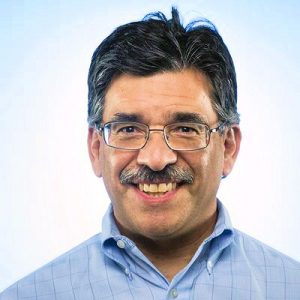
Steve Padilla
The 33-year veteran – who started at the paper as a temporary reporter in the Valley Edition on the night police beat (opposite now best-selling author Michael Connelly, who was the day-side police reporter) – spoke to the OFS group of former Times employees on Sept. 23, 2020, via Zoom.
Padilla began by talking about the restoration of the Column One feature after a three-year hiatus that began under the Tribune Co. ownership of the paper. But he also responded candidly to questions about the turmoil that has engulfed the paper during the last 18 months. During that time, six editors have either been pushed out, demoted or had their responsibilities reduced because of bullying behavior, ethical lapses or other failures of management.
[See the note below about The Times’ editorial apology for its past failures on matters of race.]
Column Ones were introduced in 1968 by Assistant Managing Editor John Foley, at the direction of then-Editor Nick B. William Sr., who wanted to showcase the best writing of the staff. John oversaw the feature for the next 20 years. Informally called “non-dupes,” short for non-duplicative, they were fresh, usually narrative pieces of journalism that had not appeared anywhere else.
Column Ones were relaunched on Jan. 19, 2019. The editors were uncertain at the time how many Column Ones would be produced annually, Padilla said, but by the end of the year 100 had run; staffers welcomed the opportunity to stretch their writing and reporting skills.
To avoid the need for heavy editing for structure or focus after a Column One is turned in, Padilla gets involved with reporters and other editors at the front end of stories with Column One potential. “That way I’m just polishing the gem and not trying to rebuild the engine,” Padilla said, “and that seems to be working out really well.”
Some Column Ones are now picked up by Apple News and read by voice actors, he noted, and made available as audio offerings.
Until budget constraints were placed on editorial operations due to the COVID-19 drop in advertising, Padilla accepted Column One stories from freelancers, including former staffers David Kelly and John Glionna. Another recent change, he said, is that while Column Ones were at first almost always written in narrative style, “now they just have to be a good story.”
Asked about morale in the newsroom, Padilla acknowledged that “there are some very angry people these days,” and that some angry and ugly things are distributed on the Slack channel used for internal communications. He noted that staffers in recent months have had to accept one-day furloughs each week (getting paid for the fifth day through a state program.) In addition, all staffers have had to adjust to working from home, and there is the stress almost everyone now feels because the pandemic.
Despite people being “pretty grumpy,” he said, there have been some positives. A series of demands presented by the Latino caucus to Editor Norm Pearlstine and owner Dr. Patrick Soon-Shiong were all accepted. In addition, the paper received a lot of praise for the package of stories on the 50th anniversary of the Chicano Moratorium and the killing of Times columnist Ruben Salazar by Los Angeles deputy sheriffs.
Padilla was not asked and did not address how the demands of the paper’s Black caucus were received. But he described as “very shocking” some of the comments by Black staffers about their treatment at the paper, as reported in the introspective front-page story on ethical and other lapses at the paper published on Sept. 22, the day before our Zoom meeting. He acknowledged that historically the paper has had a “very bad record” of retaining Black staffers.
Padilla said the Minority Editorial Training Program (METPRO), which he oversaw for about a year before it was recently transferred to a new Assistant Managing Editor for Culture and Talent, had gone through a rough period during the Tribune era, when there were major cuts in the editorial department and no staffers received raises.
A salary survey several years ago showed METPRO reporters were grossly underpaid for their years of experience, Padilla said, but there are now close to 70 METPRO grads on the paper, including City Editor Hector Becerra and Angel Jennings, the new Assistant Managing Editor, who is African American.
Regarding the paper’s digital operations, he said there was no longer any question that posting stories digitally is the paper’s first priority, rather than waiting to publish in the print product. He also said a new internal task force is looking at guidelines for reporters’ use of social media. The paper’s current standards are clearly inadequate and are largely ignored, he said, resulting in some posts that harm the paper’s reputation.
Repeating what Pearlstine told the OFS about six months after he was named editor, Padilla said the Times no longer has a goal of being a national paper. Instead, its focus is on California and the countries that most affect it, including Mexico and Pacific Rim nations. Staffing has been increased in both regions in the last two years.
Padilla closed his remarks by saying the paper now reaches people in more ways than it ever has, through online, print, Apple News (which pays for stories it picks up), podcasts and television. The “L.A. Times Today” show on the Spectrum One cable system recently won an Emmy in the “Best News Magazine” category.
On September 27, 202, The Times published a lengthy editorial examining and apologizing for the paper’s past “failures on race,” and outlining its path forward. It also released a YouTube video on the topic.
Times Sports Editor Mike Hiserman Gives Progress Report to OFS
By Bob Rawitch

Mike Hiserman
Any reader of L.A. Times sports pages has not had much to read lately.
A precipitous drop in advertising related to the Covid-19 pandemic forced the paper to drop its daily sports section. It now provides just 2½ pages of sports coverage six days a week, in the back of the California section.
At the same time, virtually all college and professional sports came to a halt in March, so there is much less to cover.
That was the challenging background for the talk by Mike Hiserman, the new Times Sports Editor, to OFS on July 1, 2020, in the group’s first virtual get-together.
A 38-year veteran of sports coverage in the paper’s suburban, Orange County and main sports sections, Hiserman was named interim sports editor in November, and the “interim” designation was removed in February.
Hiserman said he’s hopeful of getting at least another page for coverage when Major League Baseball is scheduled to open later this month. He would also like to move the current separate sports section from Saturday to Sunday, with expanded coverage.
In a wide-ranging, hour-long Zoom discussion with retirees and former Times editorial personnel, Hiserman talked about everything from likely changes in covering the delayed 2020 Olympics next year to managing a staff with a lot of veterans mixed with an increasing number of younger reporters.
Among the talented young writers who have joined the department in the last few years are J. Brady McCollough, Jack Harris, Ryan Kartje and Thuc Nhi Nguyen.
These new arrivals have readily embraced the new technologies that are now part of today’s coverage, Hiserman said, while “a lot of excellent veteran writers are just more comfortable doing things the way they always have.”
Because of Covid-19 and reduced newspaper revenues, coverage of the Olympics now rescheduled for 2021 will likely have to be trimmed. Before the Games had to be postponed from next month, Hiserman had planned to send 18 staffers to Tokyo. (Los Angeles is scheduled to host the 2028 Olympics.)
Furloughs caused by budget issues have required all of his staff to take off one day a week, he said, but he still expressed pride in their quality and productivity.
“Not long ago, I asked someone to do a count of the number of slugs we were producing weekly, thinking that it would be about 105 a week, and that was exactly what it came out to,” not counting updates of stories, he said.
But, because of the shortage of space in the paper, some stories appear only online, or in both the online and print editions but at greater length online.
He cited an 8,000-word superbly written story by McCollough that Hiserman has yet to find a way to get it in print or online.
Discussing the paper’s efforts to increase the diversity of its staff, Hiserman praised his predecessor, Angel Rodriguez, now an assistant managing editor overseeing the news desks, for making a number of diversity hires. Both the Dodgers and Angels are currently covered by Latino staffers.
Hiserman said he plans to do more; for example, he is looking forward to putting on staff Emmanuel Morgan, an exceptionally talented writer who is a graduate of METPRO (the Minority Editorial Training Program).
Nonetheless, he acknowledged that currently all of the leadership and editing personnel in sports are Anglo, and he said he needs to make progress there.
Because of Covid-19, Hiserman said, he is pessimistic that colleges will be able to complete the football season, given risks related to the size of the teams and the necessary travel.
He expressed more confidence that the NBA will be able to give fans a shortened basketball season, because teams plan to live and play their games “in a bubble” in a Disney World complex in Orlando.
He was less sure about Major League Baseball. “I don’t think a few positive tests will shut them down,” he said, but some players have already announced they will not play the season and teams would have to travel to major cities where the pandemic will likely still pose a danger.
Hiserman said he is concerned about protecting the health of his reporters, but “they seem more concerned about losing access to athletes, which had slowly been shrinking even before Covid-19.”
Finally, Hiserman said the division of labor between himself and the new Executive Sport Editor, Christian Stone, hired away from Sports Illustrated, continues to evolve.
Stone was hired to “take big swings” and work with the business side on projects, while Hiserman would focus on day-to-day operations. But Stone’s move from New York to L.A. has been delayed by Covid-19; Stone hopes to make the move next month.
Carolina Miranda Spoke to OFS on Jan. 16, 2020
Carolina Miranda, The Times’ culture reporter and head of the paper’s News Guild unit, spoke to the OFS group of retirees at noon on Thursday, January 16th, 2020, at Victorio’s Italian Restaurant in North Hollywood.
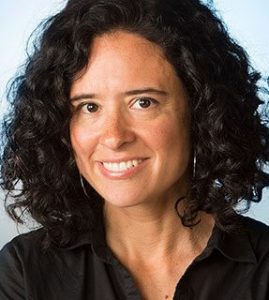
Carolina Miranda
The Guild recently signed its first union contract with Times management. It provides the first pay raises in years, as well as other work-related provisions affecting editorial employees. Editorial employees will see their new raises included in their last paycheck of 2019.
Miranda and her Guild colleague data reporter Anthony Pesce spoke to the OFS more than a year ago, shortly after the Guild unit was formed setting forth some of the union’s goals.
At January’s meeting, Miranda updated us on what was accomplished in the new contract, and what was not, and what were the most contentious issues and how they were resolved.
In the coming months we expect to have Chris Argentieri, newly named president of the Times (see below), and Dr. Patrick Soon-Shiong speak to the group.
Chris Argentieri is Named President of LA Times
Chris Argentieri, formerly the Chief Operating Officer of the Los Angeles Times, has been appointed president of California Times, which operates the LA paper as well as the San Diego Union-Tribune.
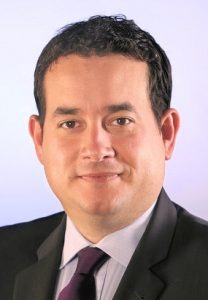
Chris Argentieri
Argentieri, who joined the company in late 2014 as General Manager, has led initiatives to extend the Times brand and its journalism to additional platforms, collaborate with other businesses and organizations, and refine the product portfolio and marketing.
He oversaw the launch of L.A. Times Studios and the acquisition of the Union-Tribune.
Argentieri, who has agreed to speak to a future meeting of the OFS, has more than 20 years of media industry experience. He previously was president of The Enthusiast Network (TEN), the country’s largest collection of special-interest media. It includes more than 75 publications, 100 websites, 800 branded products and 50 annual events.
Prior to that, he served as TEN’s Chief Operating Officer, overseeing technology, consumer marketing and brand development. Earlier in his career he held a variety of operational roles at Hearst Magazines.
The company also announced the appointment of Jeff Crawford as Chief Financial Officer. He was previously CFO of NantWorks, another company owned by Patrick Soon-Shiong, who acquired the Times in June of 2018.
Times Newsroom Among the Most Diverse in Nation
The Los Angeles Times has among the most diverse editorial staffs of major American newspapers, according to a study by the American Society of Newspaper Editors cited by Times reporter Esmerelda Bermudez in a social media post.
About 64% of the Times newsroom staff is white, according to the ASNE data. This compares to 77% for the Washington Post, 78% for the New York Times, 84% for the Wall Street Journal, and even higher percentages for USA Today, the Boston Globe, the Chicago Tribune, and the Houston Chronicle.
Information about the survey results is available online in an interactive display that provide more detail about minority representation and also reports on the proportion of women in the newsrooms.
For each paper, these figures are compared to the percentage of these groups in each paper’s area.
For example, whites account for 38% of the Los Angeles population, versus the 64% of the news staff and 70% of the newsroom leadership. Hispanics make up 14% of the news staff, compared to their 39% of the area’s population, and Blacks at the paper are only about half of their 7% share of the general population. Only Asians, at 14% of the staff, are a virtual match to the area’s population. Women make up 42% of the news staff and 31% of its leadership.
The ASNE has conducted its Newsroom Employment Diversity Survey since 1978. The organization has a goal of having the percentage of minorities working in newsrooms nationwide equal to that of minorities in the nation’s population by 2025.
Bermudez writes about the lives of Latinos for the Times. Born in El Salvador, she was raised in Los Angeles and attended USC. Before joining the paper in 2008, she was on the staff of the Portland Oregonian. She was part of the Times team that won the Pulitzer Prize in 2016 for coverage of the San Bernardino terrorist attack.
L.A. Times Is Building Digital Operation
Nearly from Scratch, Deputy Managing Editor Says
By Bob Rawitch
L.A. Times Deputy Managing Editor Sewell Chan doesn’t underestimate the challenges to achieving the paper’s goal to reach one million digital subscribers, but he says the paper aims to do so by essentially building a digital media company nearly from scratch.
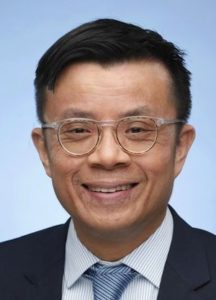
Sewell Chan
Chan, 41, told the OFS group of Times retirees at a luncheon on Aug. 10, 2019, that much needs to be done for the paper to even begin to catch up with the New York Times and Washington Post, which have the largest numbers of digital subscribers.
Chan joined the paper as a DME a little less than a year ago, after a 14-year stint at the New York Times.
“The hardest thing we need to do as an organization is carry out a transition from a business that is primarily based on print advertising to one that is probably going to be based on digital subscriptions,” Chan said. “That is a very big difference.”
After being acquired in mid-2018 by billionaire Dr. Patrick Soon-Shiong, the LA Times set an initial goal of doubling its digital subscriber base to 300,000 in 2019.
Progress to date has been far below that growth rate, however. In the first half of the year it signed up 57,000 new subscribers, but had a net increase of only 13,000 because of cancellations by other subscribers. On the positive side, the number of digital subscriptions has risen to 170,000 from about 130,000 in June 2018.
Some newsroom staffers objected strongly to a memo sent in late July by Executive Editor Norm Pearlstine that they interpreted as blaming the editorial team for the shortfall. Pearlstine apologized, telling staffers that had not been his intention.
Currently the paper’s digital subscriber base is only a fraction of the nearly 3 million at the New York Times (not counting their cooking and crossword subscriptions), and the Washington Post’s 1.7 million or the Wall Street Journal’s 1.5 million.
However, Chan said he doesn’t see the paper as competing head-to-head with the New York Times, Post or Journal. He noted that the three had a considerable head start in attracting digital subscribers, and have a different audience, including national leaders and elites.
Chan echoed Pearlstine’s earlier remarks to the OFS that the paper’s objective is to be an excellent newspaper for Southern California, with a focus on the Far West, Far East and Latin America.
“We need to cover what matters most to Californians,” he said, “which is topics like immigration, housing and the environment.”
Chan said he and Pearlstine agree that much needs to be done on the technological and business sides to grow the paper’s digital presence. Chan has assumed major responsibility for digital operations since coming to the paper, among the other areas he oversees. He oversees journalists who work in tandem with software engineers, developers and designers to improve the digital experience.
He noted that progress has been made overcoming a litany of problems with the Times’ website and app, thanks to replacements to systems that had been installed by Tronc, the paper’s prior owner.
The paper has also rolled out a new content management system, and is working on making substantial improvements to its customer service infrastructure, he said.
But more editorial resources are needed, he acknowledged. He noted that the New York Times has dozens of social media editors while the L.A. Times until recently had only a handful and the New York Times invested heavily in electronic newsletters – a significant source of reader engagement – while the L.A. Times was slow in getting started.
Retirees at the lunch asked Chan about the possibility of increasing society news coverage as well as coverage of the San Fernando Valley.
The paper is looking at these issues and others, Chan said, but that in a region as large as Southern California there is a constant tug between covering news that is geographically based versus theme-based.
“It is not about ‘clicks,’” he said, of improving digital coverage, “but we have to look at what is engaging readers, attracting them and retaining them.”
Given the changing nature of Southern California, he said, the paper also needs to increase its coverage of the Latino, African American and Asian American communities to attract those readers.
While much of the focus of his talk was on improving digital operations, Chan, who has oversight over national and foreign news among other areas, said the print version of the paper is still key because print advertising and circulation still generate more than 80% of revenues.
Chan said he thought newsroom morale was improving after hitting a low point under Tronc, which led to unionization of the newsroom.
He noted that the generational gap in the newsroom presents unique issues. Many staffers who have been in journalism for less than a decade are working alongside a significant number of veterans with decades of experience, and their views of journalism were formed in very different eras.
The challenges facing the Times in its efforts to expand its digital audience were the subject of an in-depth article on the Nieman Lab website.
The Times is Growing its Staff and Online Presence, Says Managing Editor Scott Kraft
By Bob Rawitch
The Los Angeles Times editorial staff has grown by about 110 staffers since Dr. Patrick Soon-Shiong took control, Managing Editor Scott Kraft told a luncheon of former Times employees at the Second City Bistro in El Segundo on March 11, 2019.

Scott Kraft
The paper has hired 85 new people since last July and converted 25 contractors to employee status, Kraft said. Among veterans rehired in recent months are Doyle McManus, Alice Short, Maria La Ganga and Janet Hook.
Confirming what Executive Editor Norm Pearlstine told the group late last year, Kraft said the goal for the editorial department is not to get back to its peak staffing level of 1,200. Currently it is at about 523 (the Washington Bureau has gone from 12 to 23), and hiring will likely slow for the next few months.
But Kraft said the paper still is looking to reestablish a bureau in Arizona and to build up reporting capability in New York and Latin America. A new bureau in Seattle will be staffed by Richard Read. Five staffers are now stationed in Asia; two are in Singapore, who will cover the region, along with two in Beijing and one in Seoul.
The paper was profitable last year, despite all the cutbacks the Tribune Co. made before selling it, Kraft said, and it will not be profitable this year because Dr. Soon-Shiong is committed to major reinvestments in staffing and digital initiatives.
Looking to the upcoming presidential campaign, Kraft said seven staffers will be assigned full time and, as usual, additional staff will likely be borrowed as needed from other parts of the paper.
Despite the past exodus of top-quality staffers in recent years, which threatened the Times’ reputation, Kraft said there is a renewed energy at the paper – especially due to the expansion plans underway –while thousands of journalists are being laid off elsewhere. He noted that the paper received 400 applicants for a single copy editor position recently, and 150 applicants for the as-yet-unfilled New York reporting position.
The rebuilding effort includes reinstituting a weekly Food Section, scheduled to launch early next month, Kraft said. Expansion of that staff includes a new food editor, two established food critics, and a videographer. A new test kitchen is being built.
Kraft said the Times plans to invest heavily in the digital side of the paper. He acknowledged that the website needs major renovation to be more reader-friendly. In addition, the new Calendar editor plans to create a “listings app” to help people decide what to do over the weekend.
He said the paper currently has only 156,000 digital-only subscribers. Dr. Soon-Shiong recently told the Wall Street Journal that his goal is to have five million, though he set no date to reach that goal. The New York Times currently has 3.4 million digital subscribers, and has a target of 10 million by 2025. The Journal has 1.71 million, double the number it had in 2015.
Kraft also discussed L.A. Times Today, a new television news program on Spectrum Cable. During the first two weeks of the cable news show, the Times program was the most watched show on Spectrum One. The show has a professional anchor and consists of a series of interviews and stories by Times reporters. It runs fresh content four days a week, with a recap of the week’s stories on the fifth day.
Reporters appearing on the show are not paid extra, Kraft said, but they do seem to enjoy the experience and the increased exposure.
Without supplying details, Kraft said negotiations with the Newspaper Guild continue, but “most major issues have been resolved.” When a new contract goes into effect there will be “substantial raises” for the lowest-paid reporters, and about a quarter of the Guild-covered staff (more than 100 staffers) will receive increases of more than 20% in the first year of the contract.
Kraft said previous ownership took advantage of graduates of its METPRO (Minority Editorial Training Program) by, on the one hand hiring an entire class, but paying them less than others with similar levels of experience. However, Kraft said, as a result of METPRO the Times newsroom is the most diverse in the country, with ethnic minorities representing 36% of the staff.
Responding to news accounts that the Times wants complete control over the work product of reporters, including work done outside the paper, Kraft said the company will not insist on the rights to work done unrelated to Times stories, but has always maintained the rights to spinoffs from Times work product. On the rare case where a Times story evolves into a movie or television effort, “the writer would get a piece of the action.”
In response to a question, he acknowledged the paper must do a better job of covering Latino, Asian and Black communities, and he said he would “look at” increased coverage of the San Fernando Valley, which constitutes a third of the city’s population in past years had its own daily edition with a staff of nearly 100.
Kraft is a Times veteran of more than 30 years. As managing editor, he oversees Metro, California, National, International, Washington, Page One, Column One, Enterprise and Investigations. He has been a national and foreign correspondent as well as deputy managing editor/news and National editor. He joined the paper as a staff writer in its Chicago bureau, and later was bureau chief in Nairobi, Johannesburg and Paris.
His story for the Los Angeles Times magazine on the AIDS epidemic in Africa won the SPJ Distinguished Service Award for Foreign Correspondence. He has been a Pulitzer Prize finalist in feature writing and was a Pulitzer juror in International Reporting in 2014 and chair of the Public Service jury in 2015.
Born in Kansas City, Mo., Kraft has a bachelor’s degree in journalism from Kansas State University.
The Third Time Really Was The Charm For L.A. Times Executive Editor Norman Pearlstine
By Bob Rawitch
Speaking to a crowd of 40 at an OFS luncheon on Oct. 30, 2018, LA Times Executive Editor Norman Pearlstine recalled that, shortly after Bill Thomas became editor, Pearlstine applied to Thomas for a reporting job, but was rejected. Then, soon after Tom Johnson became publisher in the early 1980s, Pearlstine again applied to Johnson for a job, and again was turned down, instead becoming managing editor of the Wall Street Journal.
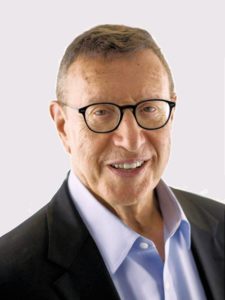
Norman Pearlstine
But when Dr. Patrick Soon-Shiong brought in Pearlstine as a consultant after buying the Los Angeles Times and San Diego Union, Soon-Shiong offered Pearlstine – who in addition to the Journal had previously held top positions at Forbes, Bloomberg and Time Magazine – the job of executive editor, and at 76 he jumped at the chance.
Speaking to the OFS attendees, Pearlstine outlined a number of actions he hopes to take in the near term, including finding one or more potential successors to him as editor.
He said the biggest surprise when he became editor was the “extent of damage done in the prior decade” of Tribune (Tronc) management.
He said the editorial staff is now less than one-third of its peak of 1,250, when the late Editor John Carroll resigned rather than cut the staff to 1,175. “We need to recognize we can’t do the same things with a staff of about 400 that we could with 1,200,” Pearlstine said.
The current editorial staff is about half the size of that at the Washington Post. The Times’ Washington Bureau now has 11 staffers, compared to its peak of 65. He also bemoaned the loss of experienced talent like Cathy Decker and Kim Murphy, who went to the Washington Post and New York Times.
Pearlstine would not set a timetable for his plans, but cited a number of goals. These include:
- Rebuilding the Washington Bureau, although he did not cite a specific number of staffers.
- Increasing investigative reporting efforts in sports, business, food and entertainment coverage.
- Opening a Singapore bureau, expanding China and South Korean coverage, and increasing coverage in Latin American through a combination of increased staffers and freelancers. He praised the existing group of foreign freelancers, but acknowledged it is not the same as having full-time staffers. He doesn’t envision getting back to the peak number of 25 foreign bureaus.
- Expanding metro and government coverage in Los Angeles County. He acknowledged the difficulty of covering more than 80 cities, and does not expect to have the resources to return to the days of zone editions that expanded dramatically in the 80s and 90s.
- Bringing back the Column One feature, initially only on Sunday, but increasing to daily as reporting resources increase. Veteran Steve Padilla will oversee the renewed feature.
- Getting maximum use out of the editorial talent, which will require using more wire copy on breaking news to free up staff talent. “Do we really need a staffer writing jobs and GDP reports?” he asked rhetorically.
- Beefing up the Sacramento and San Francisco bureaus and increasing coverage of Silicon Valley and technology generally.
- Adding more centrist views on the Op Ed pages, as opposed to the more predictable positions from the right and left. He has brought back Sue Horton to oversee the pages.
- “Taking a hard look” at whether there is a need for five separate sections daily, which requires extensive reporting efforts to fill five front pages daily. No decision has been made.
- Looking at where new domestic bureaus would be of value. But he was clear that, beyond bureaus in Washington, D.C. and New York, editorial focus should be on California and the West Coast, at least initially.
He said the Times’ web operation needs major improvements. Until recently it has been hampered by the license for the website’s content management system being in the hands of Tribune Company in Chicago. In addition, he said, “right now we don’t have the people or the tools we need” to fix the system, but correcting that is a high priority.
He also announced that the Times will have a one-hour program on Spectrum TV’s new 24-hour news channel.
Pearlstine discussed the role of Soon-Shiong. The billionaire-entrepreneur has always seen himself as a “disrupter,” and cares deeply about “tough-minded reporting” as well as “editorial integrity, fairness, honest and objective coverage,” Pearlstine said.
He noted that, even though Soon-Shiong is close to former USC President Max Nikias, he was “hands off” about the newspaper’s investigative reporting of gynecologist George Tyndall who has been accused of sexually abusing hundreds of students and staff. Soon-Shiong made no effort to stop or influence the Times editorial staff’s call for Nikias’ resignation.
Most of the 40 OFS attendees then toured the paper’s new quarters in El Segundo, some areas of which are still under construction. In addition, a 100,000-square-foot building will soon be constructed adjacent to the existing offices, to house a test kitchen, video studio, large auditorium and other facilities.
The next OFS meeting will likely be in late January or early February.
You can reach Bob at bob@rawitchconsulting.com
L.A. Times Executive Editor Norman Pearlstine at OFS Lunch Oct. 30 in El Segundo
By Bob Rawitch
L.A. Times Executive Editor Norman Pearlstine spoke an an OFS lunch at noon on Oct. 30, 2018.
We met at the Second City Bistro, 222 Richmond St., off West Grand Ave., in El Segundo. (Click for map.)
Following his presentation, we took a tour of the Times’ new quarters nearby.
The buffet lunch, including dessert, tax and tip, was $25, payable in cash or check at the door.
Pearlstine consulted with Dr. Patrick Soon Shiong before Soon Shiong purchased the L.A. Times and San Diego Union, and was named executive editor of the paper June 18, 2018.
Pearlstine’s role at the Times caps a stellar journalistic career. During his 24 years at the Wall Street Journal he held a variety of positions, including an early stint as a reporter in Los Angeles, and eventually was named executive editor. He spent 14 years at Time Magazine in two separate stints, rising to editor in chief, and also worked at Forbes and Bloomberg.
He has authored two books, “Off the Record” and “The Press, the Government, and the War on Anonymous Sources.”
He earned an AB in history at Haverford College and a law degree from the University of Pennsylvania.
Pearlstine, who turned 76 earlier this month, has said one of his key jobs is to find his successor. He and his lieutenants have already begun working to reverse the damage done during tronc stewardship, and are seeking to hire dozens of new editorial staffers.
L.A. Times Guild Representatives Are Looking Forward Rather than Backward
By Bob Rawitch
Two L.A. Times news guild representatives at an OFS meeting on July 7, 2018, traced the history of how a historic vote to unionize passed easily, and how the union remains committed to negotiating improved pay and working conditions for editorial employees.
Culture reporter Carolina Miranda and data reporter Anthony Pesce said efforts to organize the newsroom began seriously in April 2017, when more than 100 staffers signed union authorizations at a secret meeting held at the Doubletree Hotel in Little Tokyo.
 By last summer, more than two-thirds of the 450 editorial employees had signed union authorizations. The guild won the unionization election overwhelmingly late last year.
By last summer, more than two-thirds of the 450 editorial employees had signed union authorizations. The guild won the unionization election overwhelmingly late last year.
So far there have been three negotiation sessions, where the tone has been “mutually respectful and positive,” Pesce said.
Each side is represented by an experienced labor attorney. An eight-member bargaining committee from various editorial departments speaks for their colleagues, while Deputy Managing Editor Colin Crawford is leading management’s interests.
Pesce said salaries have fallen far below the average paid to editorial employees at the New York Times, Wall St. Journal and Washington Post, when once they were comparable.
Pesce said in the last 10 years there has only been two cost-of-living raises, and no merit raises. Miranda added that vacation days have been reduced in recent years, comp time is administered inconsistently, and pensions were frozen years ago.
A news guild-sponsored survey earlier this year, based on data provided by the L.A. Times, showed significant disparities in compensation for white, older males compared to that of women, minorities and younger reporters, copy editors and photographers.
Pesce said the negotiations will only set minimum salaries, allowing individuals to seek individual raises.
Indications from new owner Dr. Patrick Soon-Shiong, he said, are that the newspaper is looking at making salary adjustments sooner rather than later. Pesce noted that when Soon-Shiong bought a hospital where nurses were severely underpaid, he authorized almost immediate raises.
Looking to the future, employees have completed their move to new quarters in El Segundo in a seven-story building owned by Soon-Shiong which has been converted for editorial and advertising purposes.
Neither of the two guild representatives was happy about the new quarters, saying they were designed without input from the newsroom and appear cramped, with two-drawer desks that are six feet by two feet.
Pesce conceded that the buildout had to take place before the sale negotiations had been completed, and Soon-Shiong was limited in the contact he could have with employees.
Editorial will be housed on three floors. The business side will have two floors, and one floor will be for overflow purposes. Eventually a cafeteria will be added to the first floor.
An office with 40 desks for staffers covering downtown and other beats has been set up in a building at Spring and Fifth.
The two said that, while for the first time in a decade there is hope and optimism among editorial employees for the future of the paper, many are still believed to be thinking about leaving, either because they can get a better newspaper job or because their commutes to work have nearly tripled.
For those lucky enough to have access to the Green Line, Pesce said, it is a five-minute walk to the new office, which overlooks the southern runways of LAX.
One cause for optimism is the $41 million profit the paper made last year, Pesce said, and Soon-Shiong has told new editor Norman Pearlstine that he is comfortable running at breakeven in the next few years years so he can invest in upgrading the paper.
Jim Kirk Speaks at OFS Lunch April 4
By Bob Rawitch
Jim Kirk, the new Editor-in-Chief at the LA Times, shared his view of the present and his hopes for the future at the paper with about 35 members of the OFS group of retired editorial employees at a lunch on April 4, 2018.
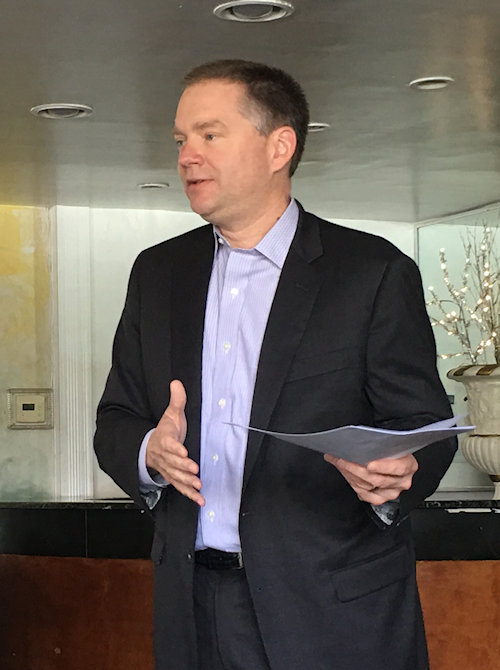
Jim Kirk speaking to Times retirees.
Three months into his tenure as editor, Kirk responded to a host of questions with an optimistic tone but was careful not to over-promise, given that new Times owner Dr. Patrick Soon-Shiong had yet to formally take ownership of the paper and there is no publisher who may have his or her own agenda.
He said he had met with Soon-Shiong, who made clear he wants to keep the newspaper in the family and invest in it for the future. But Soon-Shiong gave him no specifics on the size of the investment.
The deal transferring the Times and San Diego Union Tribune from tronc to Soon-Shiong is now expected to close any day and may have already done so by the time you read this.
Soon-Shiong also gave no indication of how or if he will restructure the leadership of The Times, Kirk said, so he has no idea whether the new owner will model his ownership similar to Jeff Bezos, who owns the Washington Post and has invested heavily in technology and editorial resources while by all accounts has not been engaged in day-to day issues.
Kirk said he has met with Post Editor Marty Baron – who many in the OFS will recall from his days as a business reporter and business editor of the LA Times – to discuss technology and other editorial issues.
Soon-Shiong, he said, is “asking lots of questions to learn about the industry.”
“The news media continue to face challenges finding new sources of revenues,” Kirk said. “Print advertising still faces headwinds, and digital advertising is in flux.” But he said he is bullish on the industry, and “there is no more fascinating time to be in the news business.”
Kirk acknowledged that the cuts to editorial staffing of the paper over the years have reduced what the Times can do, but he pointed to its outstanding coverage of last fall’s fires and subsequent mudslides in Montecito and elsewhere as examples of the excellent journalism it can still produce.
He also singled out the :Dirty John” series as an example of innovative journalism that was also turned into a highly-listened to podcast that has seen 10 million downloads and growing. The series was one of the top 10 podcasts nationwide, and “taught us great story-telling comes in many forms and we need to get out of our comfort zone…and think about readers in everything we do.”
Asked about his priorities should he get increased budgeting for editorial, he listed expanded coverage of Latin America and Asia, increased staffing for local/state reporting, expanding the Washington bureau and more investigative reporting. “We have to own Sacramento coverage, and for the most part we do,” Kirk added.
He said the paper clearly has to invest more in technology to better understand how and when readers are using the paper as well as for presentation of stories, again noting the Dirty John podcast.
One of the future challenges, he said, is how the paper displays stories for the growing number of users who are reading Times content on mobile devices.
Kirk said the paper has a huge amount of data on its readers, but not yet in a form that can effectively be used by the editorial staff. “We need to know how readers are coming to us, why they come multiple times and ultimately why they subscribe,” he added.
“We are still mostly posting content on a daily print schedule, at the end of the day, when our audience is moving away from us. We need to post earlier in the day, when readers are focused on us.”
Kirk rejected the suggestion that the paper could go back and replicate the hyper-local coverage of the 1980s and 90s, and said he does not believe it is a priority for Times readers.
But he said high on his agenda is better and more government reporting, and the paper should be the leading voice on climate change and environmental issues. “We should be telling the climate story through (coverage of) the California experience,” he said.
All these changes and improvements, he acknowledged, will have to be done in the context of a new unionized environment that followed the successful newsroom vote to affiliate with the News Guild.
Kirk said there is particularly a pay gap among METPRO graduates and other staffers. (A fact substantiated in a recent report on Times editorial salaries by the News Guild.) He praised the minority training program as the best in the county. (In the interest of full disclosure, I proposed the program in 1983, and with the support of Noel Greenwood and Bill Thomas, the paper and Times Mirror underwrote it.)
In responding to how he would deal with the brain drain resulting from the loss of so many seasoned journalists over the recent past, Kirk said the paper needs to again create “pathways” for talented people to be promoted or move to other sections of the paper, like from Metro to the Washington Bureau.
At a time when the news media’s credibility is low and constantly under attack by President Trump, Kirk said “we have to guard trust in the paper at all cost.”
